Morgul Brute (7R188)
Back to Return of the King Index |
Morgul Cur (7C189) |
Morgul Brute (7R188) is a Ringwraith Minion from the Return of the King set.
| ||||||||||||||||||||||
| ||||||||||||||||||||||
| ||||||||||||||||||||||
| ||||||||||||||||||||||
Strategy[edit]
Morgul Brute is a cheap minion that puts out consistent value whenever it's played, as long as you already have a Nazgul in play. While your opponent gets to choose whether the Brute generates a wound or a burden, either one is a strong effect from a minion that only costs two twilight. Then, once in play, this froggy creature often poses a difficult threat if there are any burdens, because it can pump its strength, if you deem a key wound or overwhelm more valuable than the burdens you're using up. It shares this combination of consistent value and unpredictable skirmishing strength with its samurai cousin, Morgul Destroyer (7U190)
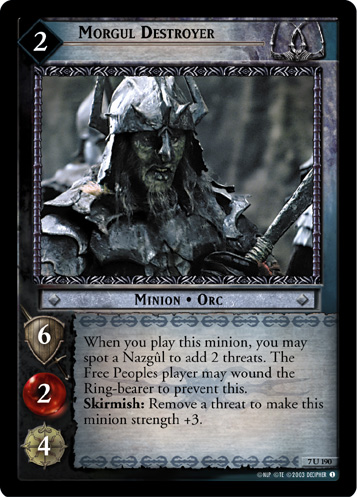 , and the two are the core of the Morgul Orcs semi-swarm deck. The Brute also seems some play in Twilight Nazgul decks.
, and the two are the core of the Morgul Orcs semi-swarm deck. The Brute also seems some play in Twilight Nazgul decks.
Morgul Brute is above the power curve for minions of a comparable cost, which is somewhat offset by its spotting requirement and the fact that your opponent gets to choose its effect. With those limitations in mind, it's worth comparing it to similar minions. As a two-cost, 6 strength, 2 vitality minion that does a single wound, it's a better value than the weaker Goblin Bowman (2C60)
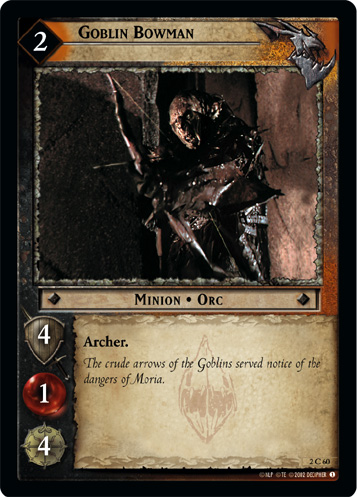 at 4/1, and about on par with Orc Soldier (1C271)
at 4/1, and about on par with Orc Soldier (1C271)
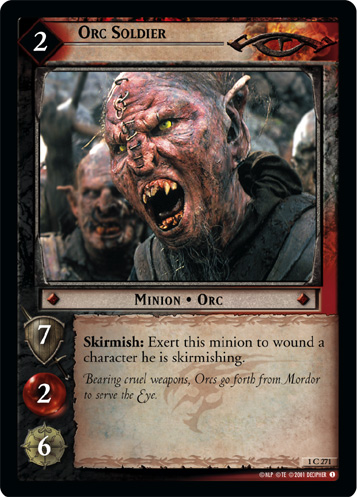 , which also has a 7/1 body (after the exertion) but is a bit easier to shut down by wounding or killing it before it gets to wound anything. The Brute is not quite as good a value as Gollum, Dark as Darkness (9R+28)
, which also has a 7/1 body (after the exertion) but is a bit easier to shut down by wounding or killing it before it gets to wound anything. The Brute is not quite as good a value as Gollum, Dark as Darkness (9R+28)
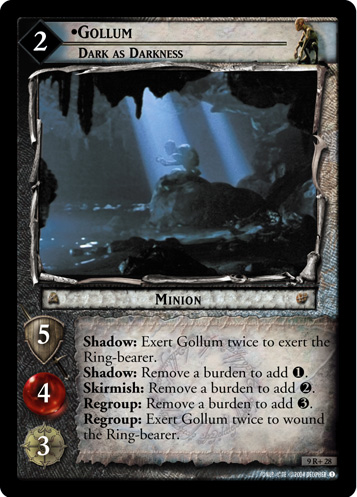 played with Captured by the Ring (7C53)
played with Captured by the Ring (7C53)
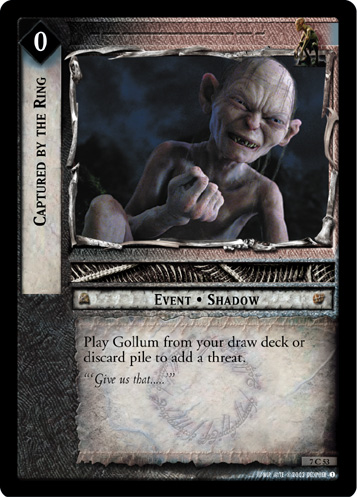 , which generates a threat, a wound, and a 5/2 body (after the exertions), but Gollum is unique, and they are both generally played in the same decks. As a non-unique wounding minion, Morgul Brute is generally closer to three-cost minions like Southron Bowman (4C248)
, which generates a threat, a wound, and a 5/2 body (after the exertions), but Gollum is unique, and they are both generally played in the same decks. As a non-unique wounding minion, Morgul Brute is generally closer to three-cost minions like Southron Bowman (4C248)
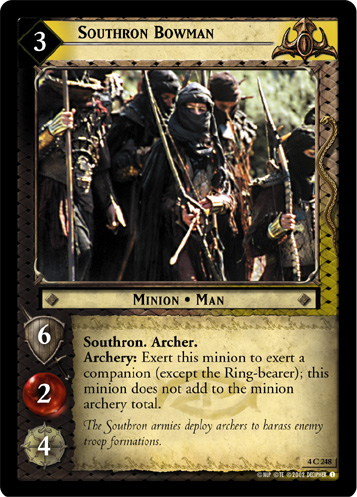 , also at 6/2, and Goblin Marksman (1C176)
, also at 6/2, and Goblin Marksman (1C176)
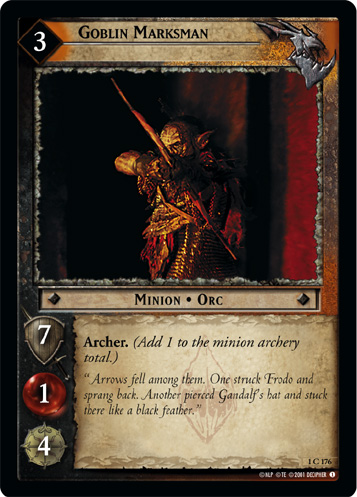 at 7/1. There's nothing quite like it as a minion that adds a burden: the closest cards are Easterling Lieutenant (4C228)
at 7/1. There's nothing quite like it as a minion that adds a burden: the closest cards are Easterling Lieutenant (4C228)
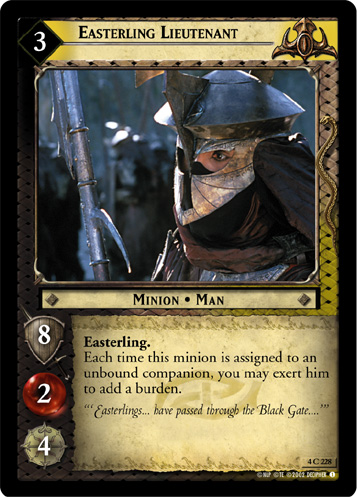 , Wisp of Pale Sheen (6C108)
, Wisp of Pale Sheen (6C108)
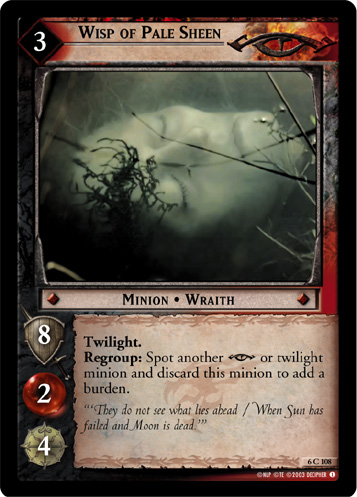 , and Gorgoroth Stormer (8C101)
, and Gorgoroth Stormer (8C101)
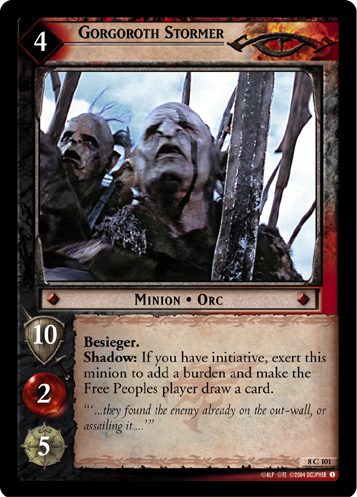 , all of which are more situational and a fair bit more expensive. If your opponent chooses the burden and you immediately consume it, it's a bit ahead of the curve: a 9/2 minion usually costs 3, but often comes with some sort of useful gametext on top of that, as with Uruk Warrior (1C156)
, all of which are more situational and a fair bit more expensive. If your opponent chooses the burden and you immediately consume it, it's a bit ahead of the curve: a 9/2 minion usually costs 3, but often comes with some sort of useful gametext on top of that, as with Uruk Warrior (1C156)
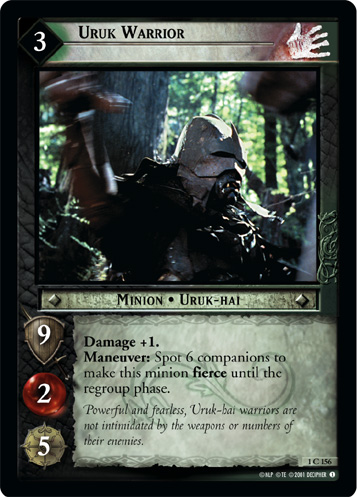 or Mordor Pillager (10U92)
or Mordor Pillager (10U92)
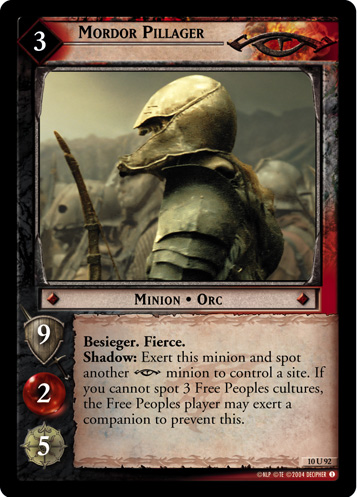 .
.
No matter what your opponent chooses, Morgul Brute at least puts pressure on the ring-bearer, as long as you play it alongside a Nazgul. There are two common ways to take advantage of that pressure in Ringwraith culture, and they form the core of two decks: Morgul Orcs and Twilight Nazgul. Morgul Orc decks swarm out just cheap enough minions to consistently wear down any vulnerable characters in the Fellowship, the ring-bearer included. Decks using Twilight Nazgûl compound the pressure on the ring-bearer, with more effects that exert, wound, and burden them.
Morgul Orc semi-swarm decks use the Brute and its threat-based counterpart Morgul Destroyer (7U190)
 , along with Gollum, Dark as Darkness (9R+28)
, along with Gollum, Dark as Darkness (9R+28)
 and Captured by the Ring (7C53)
and Captured by the Ring (7C53)
 to stack up wounds on the ring-bearer, burdens, and threats. The Nazgûl to lead them is generally a cheap and efficient one. Depending on the format, popular choices include: Úlairë Nelya, Ringwraith in Twilight (2R84)
to stack up wounds on the ring-bearer, burdens, and threats. The Nazgûl to lead them is generally a cheap and efficient one. Depending on the format, popular choices include: Úlairë Nelya, Ringwraith in Twilight (2R84)
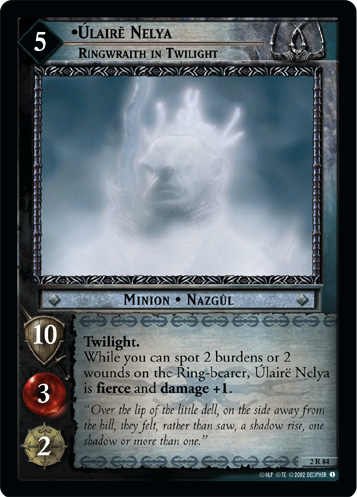 , Úlairë Cantëa, Faster Than Winds (7R211)
, Úlairë Cantëa, Faster Than Winds (7R211)
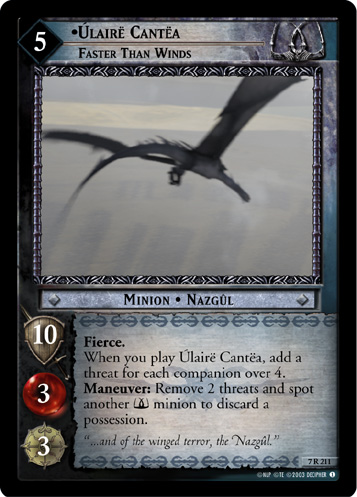 , Úlairë Lemenya, Assailing Minion (7R213)
, Úlairë Lemenya, Assailing Minion (7R213)
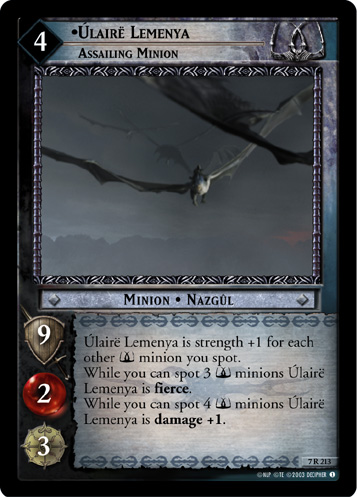 , Úlairë Otsëa, Thrall of the One (8R81)
, Úlairë Otsëa, Thrall of the One (8R81)
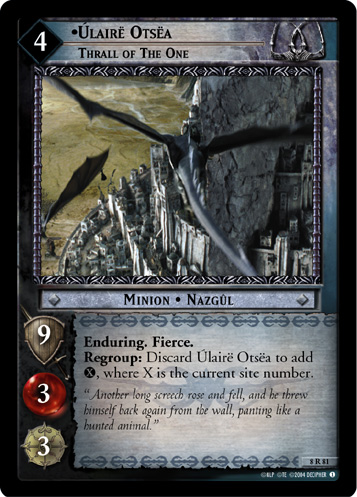 , Úlairë Lemenya, Eternally Threatening (15R185)
, Úlairë Lemenya, Eternally Threatening (15R185)
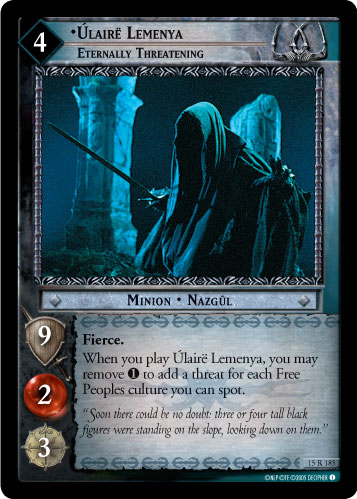 , The Witch-king, Captain of the Nine Riders (11R226)
, The Witch-king, Captain of the Nine Riders (11R226)
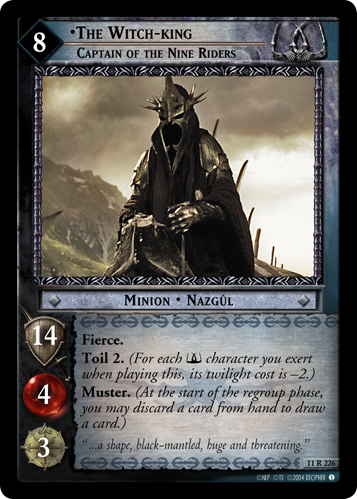 , Úlairë Cantëa, Black Assassin (12R174)
, Úlairë Cantëa, Black Assassin (12R174)
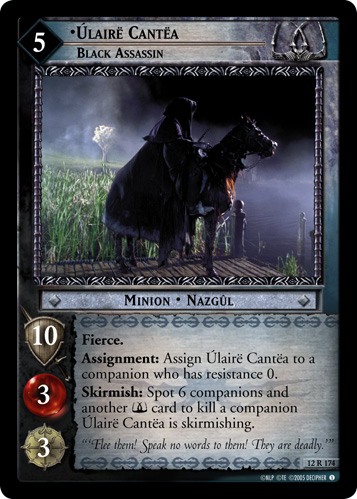 , and Úlairë Nelya, Third of the Nine Riders (11S222)
, and Úlairë Nelya, Third of the Nine Riders (11S222)
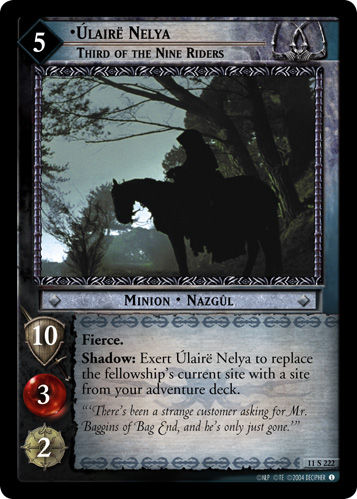 are all popular. The rest of the swarm is composed of minions like Morgul Skulker (1U258)
are all popular. The rest of the swarm is composed of minions like Morgul Skulker (1U258)
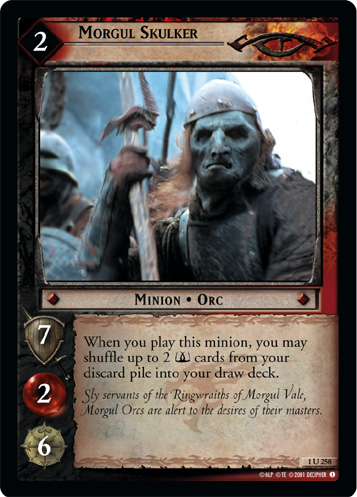 , Bill Ferny, Swarthy Sneering Fellow (2R75)
, Bill Ferny, Swarthy Sneering Fellow (2R75)
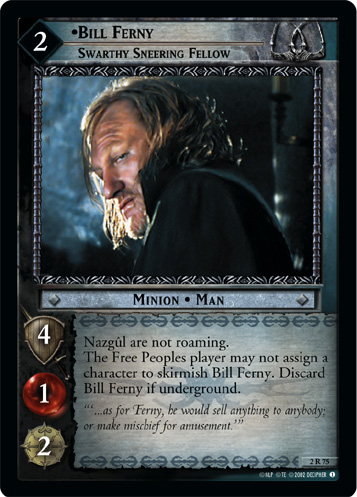 , Morgul Whelp (7U202)
, Morgul Whelp (7U202)
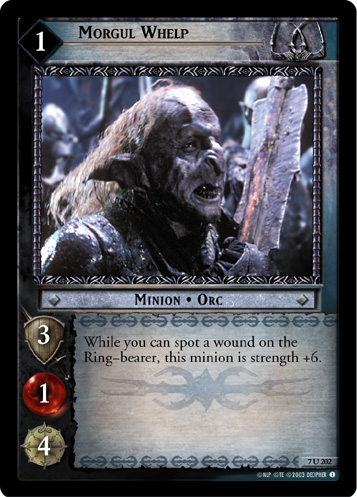 , Morgul Hound (7C192)
, Morgul Hound (7C192)
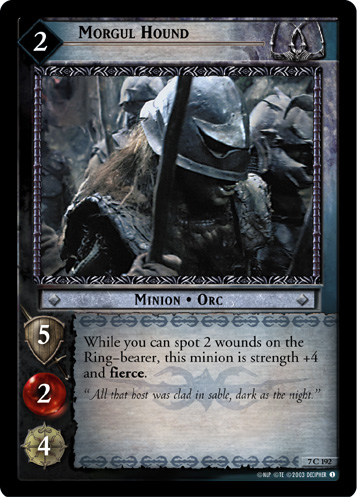 , and Morgul Spearman (7C201)
, and Morgul Spearman (7C201)
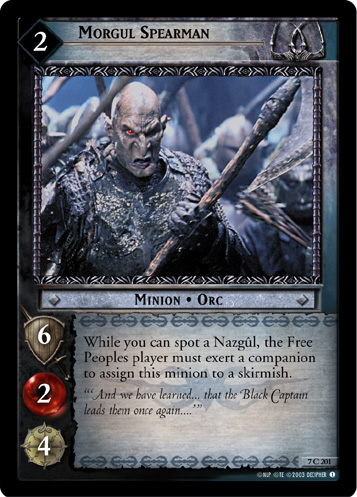 . Swarming the ring-bearer often threatens an overwhelm on weaker ring-bearers, like Frodo or Galadriel, Bearer of Wisdom (9R+14)
. Swarming the ring-bearer often threatens an overwhelm on weaker ring-bearers, like Frodo or Galadriel, Bearer of Wisdom (9R+14)
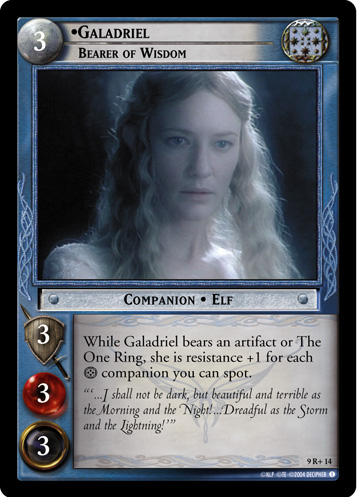 , and helps you stack pressure on the ring-bearer against Gimli, Bearer of Grudges (9R+4)
, and helps you stack pressure on the ring-bearer against Gimli, Bearer of Grudges (9R+4)
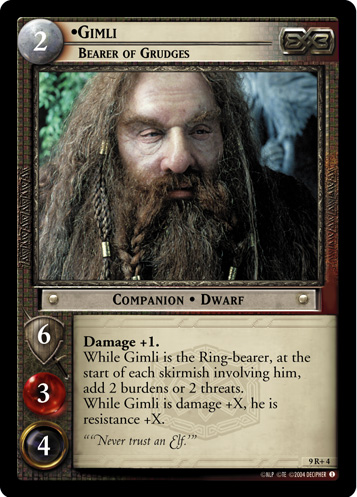 , Boromir, Bearer of Council (9R+31)
, Boromir, Bearer of Council (9R+31)
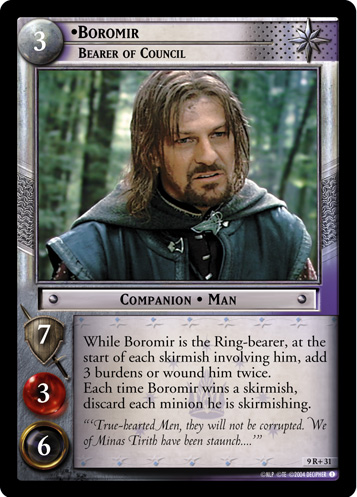 , and Isildur, Bearer of Heirlooms (9R+33)
, and Isildur, Bearer of Heirlooms (9R+33)
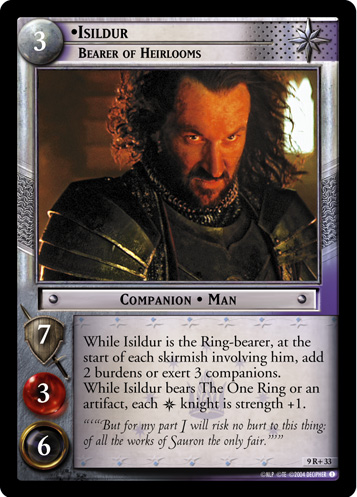 . Few Fellowships can deal with this constant pressure along so many different lines. In addition to the pressure they place on the ring-bearer, the Brute and Destroyer pose a difficult challenge in the Assignment Phase: they're cheap and weak and might be out in multiples, but if there are burdens or threats stacked, one of them can suddenly pump itself up and win a skirmish with a weak or wounded companion. The Brute, in particular, is dangerous to put on a weak ring-bearer with The One Ring, Answer To All Riddles (4R1)
. Few Fellowships can deal with this constant pressure along so many different lines. In addition to the pressure they place on the ring-bearer, the Brute and Destroyer pose a difficult challenge in the Assignment Phase: they're cheap and weak and might be out in multiples, but if there are burdens or threats stacked, one of them can suddenly pump itself up and win a skirmish with a weak or wounded companion. The Brute, in particular, is dangerous to put on a weak ring-bearer with The One Ring, Answer To All Riddles (4R1)
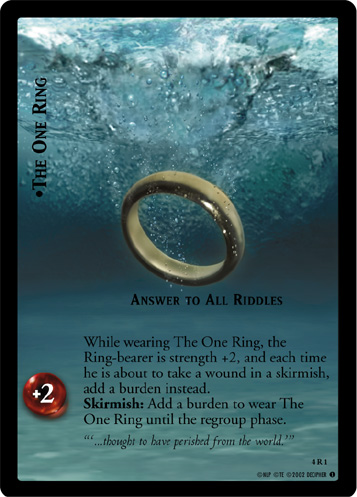 , one of the most popular versions of the One Ring, because it can immediately consume the burden from putting on the ring for a strength boost. In this deck, Morgul Brute is one of the best minions to stack on Flung Into the Fray (8U71)
, one of the most popular versions of the One Ring, because it can immediately consume the burden from putting on the ring for a strength boost. In this deck, Morgul Brute is one of the best minions to stack on Flung Into the Fray (8U71)
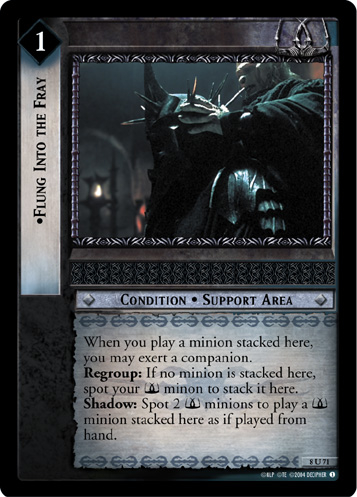 to reuse over and over again.
to reuse over and over again.
In Twilight Nazgûl decks, Morgul Brute is part of a plan to wound and burden the ring-bearer, aiming to corrupt them. Resistance Becomes Unbearable (2U79)
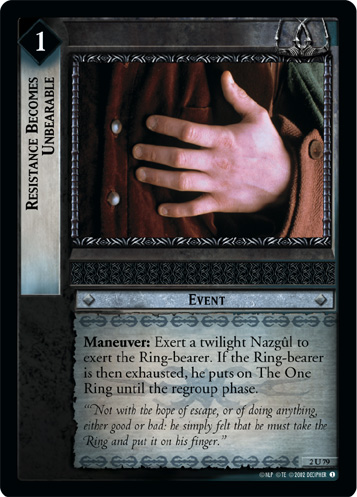 , It Wants to be Found (2U78)
, It Wants to be Found (2U78)
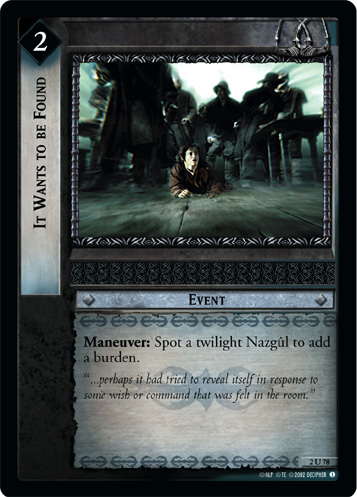 , and In the Ringwraith's Wake (1R214)
, and In the Ringwraith's Wake (1R214)
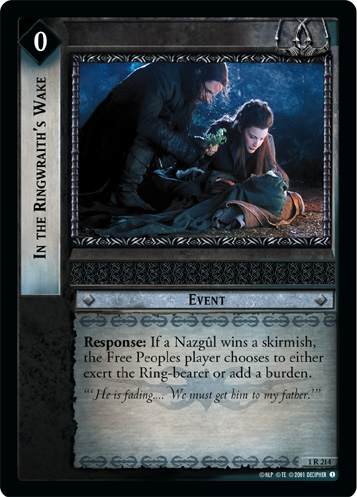 help Morgul Brute stack up wounds and burdens on the ring-bearer. Those cards, like Morgul Brute, need (Twilight) Nazgûl, so the deck uses The Witch-king, Lord of the Nazgul (2R85)
help Morgul Brute stack up wounds and burdens on the ring-bearer. Those cards, like Morgul Brute, need (Twilight) Nazgûl, so the deck uses The Witch-king, Lord of the Nazgul (2R85)
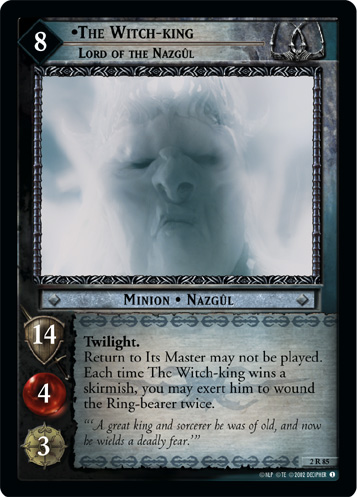 and Úlairë Enquëa, Ringwraith in Twilight (2U83)
and Úlairë Enquëa, Ringwraith in Twilight (2U83)
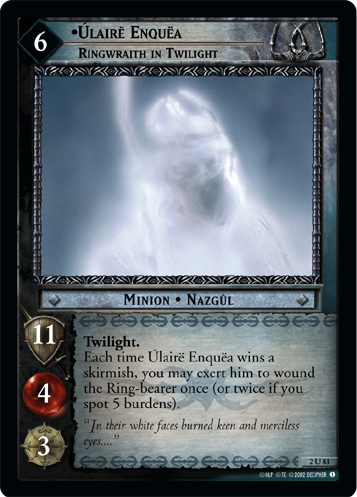 . Those two often threaten to kill the ring-bearer if they win a skirmish, forcing them to use the One Ring and expose themselves to Wraith-world (2R86)
. Those two often threaten to kill the ring-bearer if they win a skirmish, forcing them to use the One Ring and expose themselves to Wraith-world (2R86)
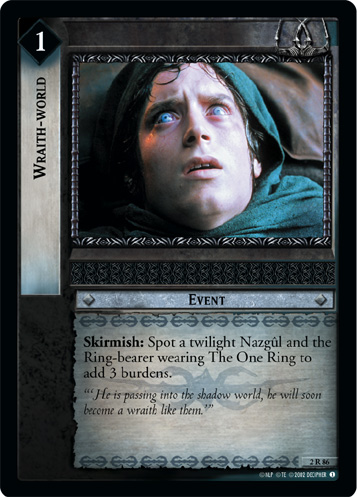 (or occasionally Return to Its Master (1R224)
(or occasionally Return to Its Master (1R224)
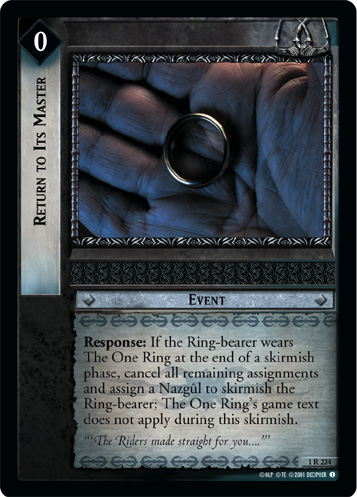 ). This deck isn't popular or particularly successful, especially by Movie Block, but it does show up occasionally.
). This deck isn't popular or particularly successful, especially by Movie Block, but it does show up occasionally.
Morgul Brute is best countered with healing, and lots of it. As long as the ring-bearer isn't exhausted, Morgul Brute is just another wounding minion. It can be a lot of wounds to stack on one character, but The Gaffer, Sam's Father (1R291)
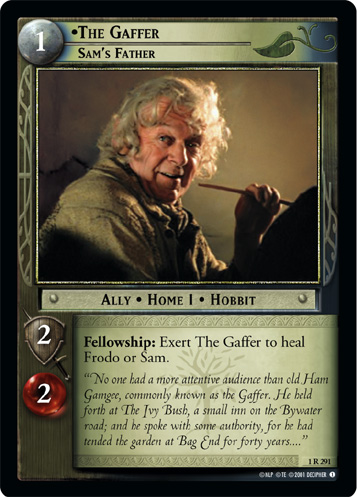 (as part of the Hobbit Hospital package) or Shoulder to Shoulder (1C59)
(as part of the Hobbit Hospital package) or Shoulder to Shoulder (1C59)
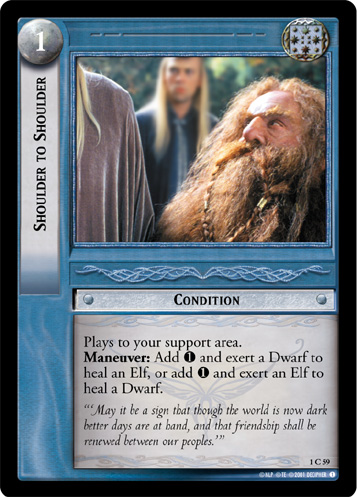 can keep up. It's almost always a bad idea to take the burden if you have the choice, but it can be a good idea if you can quickly remove it with A Light in His Mind (10U108)
can keep up. It's almost always a bad idea to take the burden if you have the choice, but it can be a good idea if you can quickly remove it with A Light in His Mind (10U108)
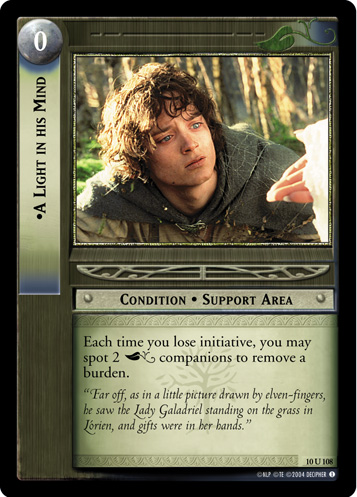 , especially if it will trigger one or more copies of The Shire Countryside (3R113)
, especially if it will trigger one or more copies of The Shire Countryside (3R113)
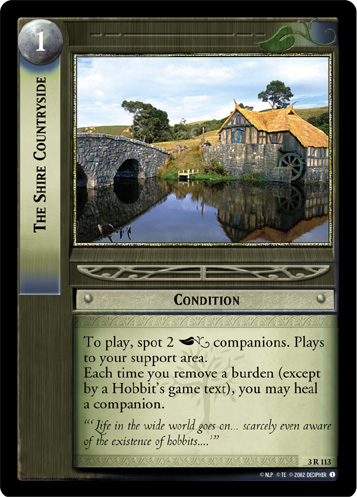 . As long as you can keep healing the wounds that Morgul Brute places and don't let any burdens stack up, it's just a weak minion of no particular consequence. The challenge is keeping up, since most decks using Morgul Brute have other cards that pressure the ring-bearer as well. Morgul Brute also always loses its skirmish to Faramir, Son of Denethor (4C117)
. As long as you can keep healing the wounds that Morgul Brute places and don't let any burdens stack up, it's just a weak minion of no particular consequence. The challenge is keeping up, since most decks using Morgul Brute have other cards that pressure the ring-bearer as well. Morgul Brute also always loses its skirmish to Faramir, Son of Denethor (4C117)
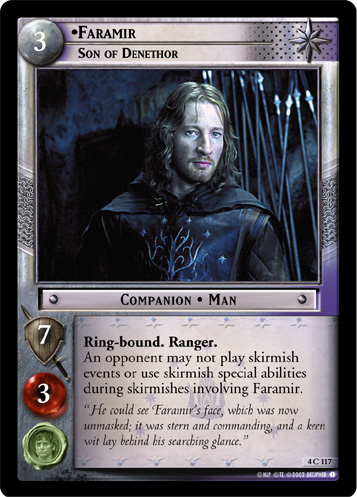 , although it does still get its value from coming into play or contributing to a swarm. It gets an inordinate benefit from Flung Into the Fray (8U71)
, although it does still get its value from coming into play or contributing to a swarm. It gets an inordinate benefit from Flung Into the Fray (8U71)
 , so making sure you remove that condition or kill all of the Brutes before the Regroup Phase can help.
, so making sure you remove that condition or kill all of the Brutes before the Regroup Phase can help.
When you're playing Morgul Brute against The Shire Countryside (3R113)
 , remember that Morgul Brute can remove burdens any time in the Skirmish Phase, not just during its own skirmish. It's wasting the burdens to do so, but if there's only one or two, you can remove them yourself rather than letting your opponent remove them and get the free healing from Shire Countryside. This is always a difficult matchup: you have to watch carefully for effects that could shrink their hand below four cards to activate A Light in His Mind (10U108)
, remember that Morgul Brute can remove burdens any time in the Skirmish Phase, not just during its own skirmish. It's wasting the burdens to do so, but if there's only one or two, you can remove them yourself rather than letting your opponent remove them and get the free healing from Shire Countryside. This is always a difficult matchup: you have to watch carefully for effects that could shrink their hand below four cards to activate A Light in His Mind (10U108)
 , or be wary of a surprise Nine-fingered Frodo and the Ring of Doom (10C112)
, or be wary of a surprise Nine-fingered Frodo and the Ring of Doom (10C112)
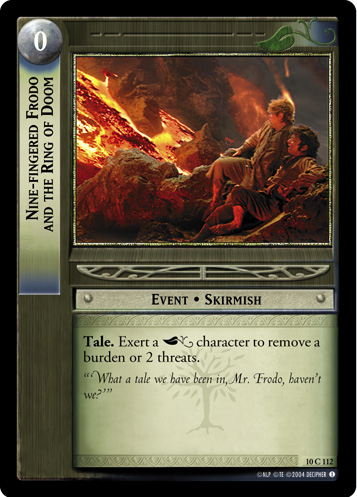 triggering all of their copies of Shire Countryside again. On top of that, it's hard to know when the turning point is to go from removing all of the burdens as soon as they show up to letting them pile up, because there are now too many to remove. The inflection point is usually somewhere between three and five burdens, but it depends on their deck and whether you're running cards like Úlairë Enquëa, Lieutenant of Morgul (1U231)
triggering all of their copies of Shire Countryside again. On top of that, it's hard to know when the turning point is to go from removing all of the burdens as soon as they show up to letting them pile up, because there are now too many to remove. The inflection point is usually somewhere between three and five burdens, but it depends on their deck and whether you're running cards like Úlairë Enquëa, Lieutenant of Morgul (1U231)
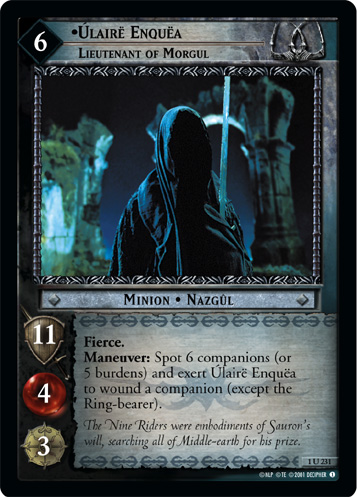 , Úlairë Toldëa, Messenger of Morgul (1R236)
, Úlairë Toldëa, Messenger of Morgul (1R236)
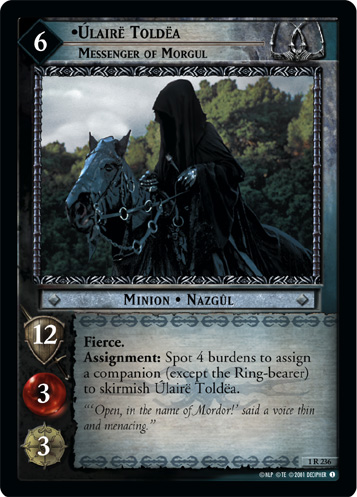 , or Úlairë Cantëa, Black Assassin (12R174)
, or Úlairë Cantëa, Black Assassin (12R174)
 . There's no one right answer.
. There's no one right answer.
Morgul Brute has an unusual relationship with wound prevention. If you prevent the wound Morgul Brute would deal when played or if the ring-bearer cannot be wounded at all, you did not do a wound to the ring-bearer to prevent the burden, so the burden still gets placed. Morgul Brute always places a burden on Bilbo, Bearer of Things Burgled (9R+49)
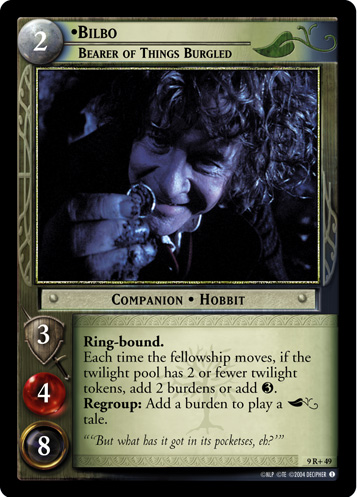 bearing Consorting With Wizards (2R97)
bearing Consorting With Wizards (2R97)
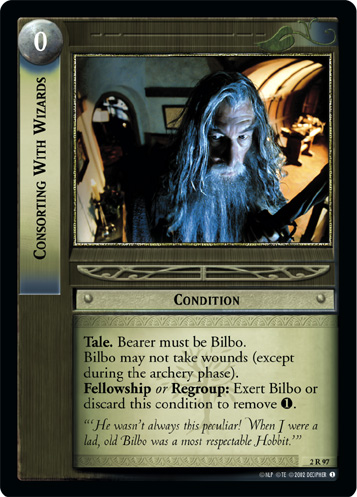 , and if you use Dwarven Bracers (2U3)
, and if you use Dwarven Bracers (2U3)
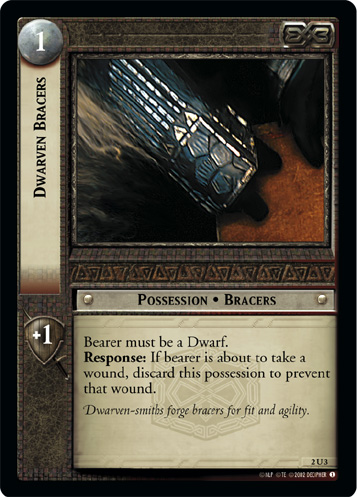 to soak the wound it would do to Gimli, Bearer of Grudges (9R+4)
to soak the wound it would do to Gimli, Bearer of Grudges (9R+4)
 , you waste the bracers and still end up with a burden. Save wound-prevention effects for other wounding effects if you can.
, you waste the bracers and still end up with a burden. Save wound-prevention effects for other wounding effects if you can.
Strengths and Weaknesses[edit]
Synergizes With...[edit]
- Nazgul! Morgul Brute is a good partner for lots of different sorts of Nazgûl.
- Cheap efficient ones that fit into a swarm strategy. Popular choices include Úlairë Cantëa, Faster Than Winds (7R211)
 , Úlairë Lemenya, Assailing Minion (7R213)
, Úlairë Lemenya, Assailing Minion (7R213)
 , Úlairë Otsëa, Thrall of the One (8R81)
, Úlairë Otsëa, Thrall of the One (8R81)
 , Úlairë Lemenya, Eternally Threatening (15R185)
, Úlairë Lemenya, Eternally Threatening (15R185)
 , The Witch-king, Captain of the Nine Riders (11R226)
, The Witch-king, Captain of the Nine Riders (11R226)
 , Úlairë Cantëa, Black Assassin (12R174)
, Úlairë Cantëa, Black Assassin (12R174)
 , and Úlairë Nelya, Third of the Nine Riders (11S222)
, and Úlairë Nelya, Third of the Nine Riders (11S222)

- Twilight Nazgûl that also want to pressure the ring-bearer, particularly The Witch-king, Lord of the Nazgul (2R85)
 and Úlairë Enquëa, Ringwraith in Twilight (2U83)
and Úlairë Enquëa, Ringwraith in Twilight (2U83)
 and their pressure tools Resistance Becomes Unbearable (2U79)
and their pressure tools Resistance Becomes Unbearable (2U79)
 , It Wants to be Found (2U78)
, It Wants to be Found (2U78)
 , In the Ringwraith's Wake (1R214)
, In the Ringwraith's Wake (1R214)
 , and Wraith-world (2R86)
, and Wraith-world (2R86)
 .
. - Nazgûl that want to spot burdens or low-resistance companions, such as Úlairë Enquëa, Lieutenant of Morgul (1U231)
 , Úlairë Toldëa, Messenger of Morgul (1R236)
, Úlairë Toldëa, Messenger of Morgul (1R236)
 , or Úlairë Cantëa, Black Assassin (12R174)
, or Úlairë Cantëa, Black Assassin (12R174)
 .
. - Úlairë Nelya, Ringwraith in Twilight (2R84)
 happens to fit all three descriptions.
happens to fit all three descriptions.
- Cheap efficient ones that fit into a swarm strategy. Popular choices include Úlairë Cantëa, Faster Than Winds (7R211)
- Cards that benefit from wounds on the ring-bearer, or help wound the ring-bearer. Besides the Nazgûl above, this includes Morgul Destroyer (7U190)
 , Morgul Hound (7C192)
, Morgul Hound (7C192)
 , Morgul Whelp (7U202)
, Morgul Whelp (7U202)
 , and the relatively rarely played Morgul Axe (7C186)
, and the relatively rarely played Morgul Axe (7C186)
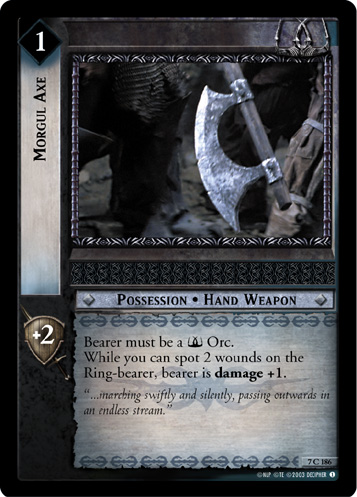 , Gorbag, Covetous Captain (10R59)
, Gorbag, Covetous Captain (10R59)
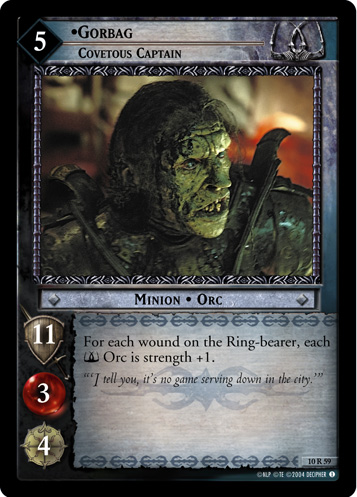 , and Ten Times Outnumbered (10C66)
, and Ten Times Outnumbered (10C66)
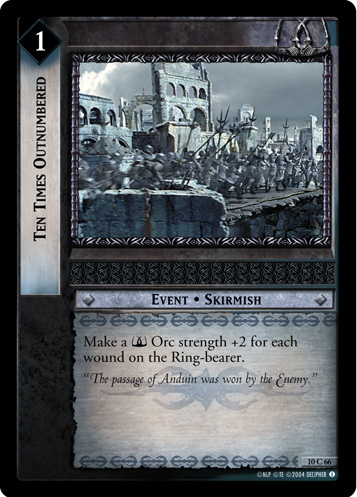 .
. - Flung Into the Fray (8U71)
 can play it over and over.
can play it over and over. - Black Marshal (10U53)
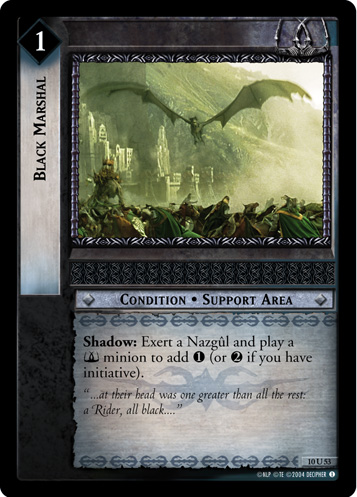 can defray its costs while strengthening enduring Nazgûl.
can defray its costs while strengthening enduring Nazgûl.
Strong Versus...[edit]
- Decks with weak healing
- Decks with a low-resistance ring-bearer and/or poor burden removal
- Opponents who are easily intimidated by saying "ribbit" every time you play it or use its gametext
Weak Versus...[edit]
- Massed archery is often effective against semi-swarm decks
- Orc-specific hate, especially Greatest Kingdom of My People (1R16)
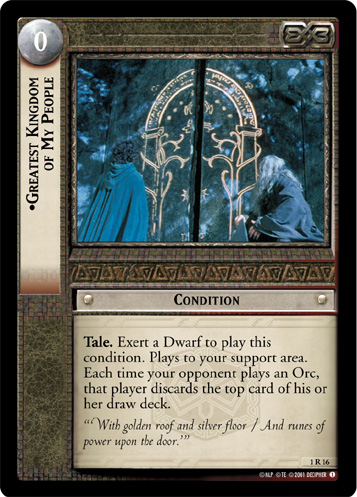 , Here Lies Balin, Son of Fundin (1C19)
, Here Lies Balin, Son of Fundin (1C19)
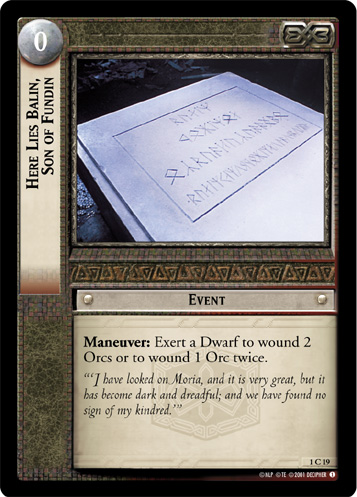 , Curse Their Foul Feet! (1R36)
, Curse Their Foul Feet! (1R36)
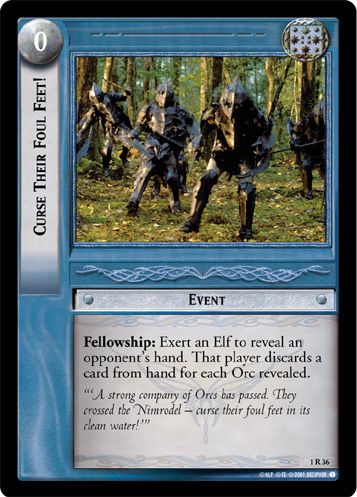 , or Rúmil, Elven Protector (1U57)
, or Rúmil, Elven Protector (1U57)
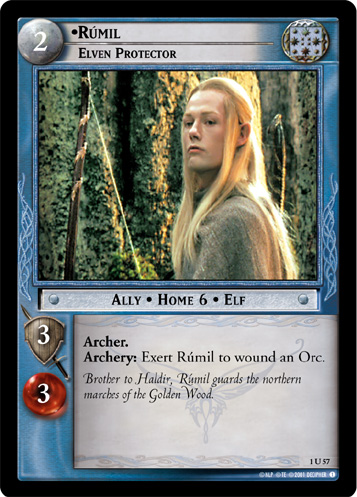 . These cards are also relatively popular to help with
. These cards are also relatively popular to help with Moria matchups, so Morgul Brute may be collateral damage.
- Cards that prevent skirmish abilities from being used, like Faramir, Son of Denethor (4C117)
 or Cavern Entrance (11S232)
or Cavern Entrance (11S232)
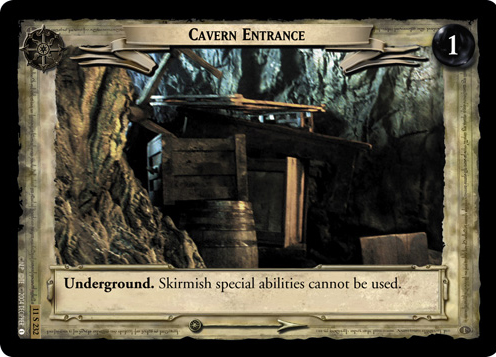 likely prevent Morgul Brute from ever winning a one-on-one skirmish.
likely prevent Morgul Brute from ever winning a one-on-one skirmish. - Cards that prevent removing burdens also prevent Morgul Brute from consuming them. This makes it much less useful at both versions of Steward's Tomb (10U119)
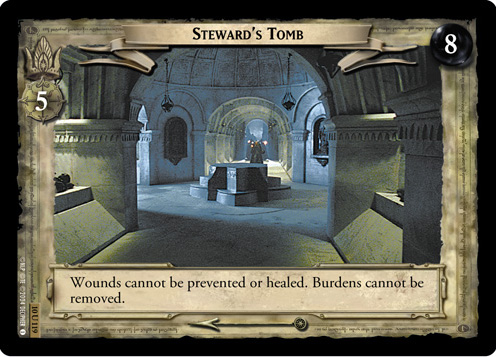 . It also means it has a bit of anti-synergy with Black Breath (1U207)
. It also means it has a bit of anti-synergy with Black Breath (1U207)
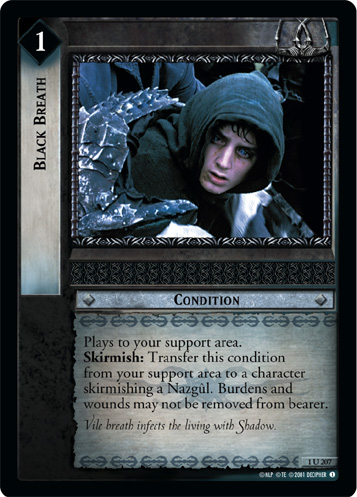 if it's on the ring-bearer, although this rarely comes up.
if it's on the ring-bearer, although this rarely comes up.
Rulings[edit]
Morgul Brute works similarly to Morgul Destroyer (7U190)
 when it comes to wound prevention.
when it comes to wound prevention.
If something happens to prevent one effect which in turn would have prevented a second effect, the second effect is performed.
Example: Morgul Destroyer (7U190)
 is played. ("When you play this minion, you may spot a Nazgûl to add 2 threats. The Free Peoples player may wound the Ring-bearer to prevent this.") The Free People player wounds the Ring-bearer to prevent the threats from being added. The Free Peoples player then discards Sapling of the White Tree (9R35)
is played. ("When you play this minion, you may spot a Nazgûl to add 2 threats. The Free Peoples player may wound the Ring-bearer to prevent this.") The Free People player wounds the Ring-bearer to prevent the threats from being added. The Free Peoples player then discards Sapling of the White Tree (9R35)
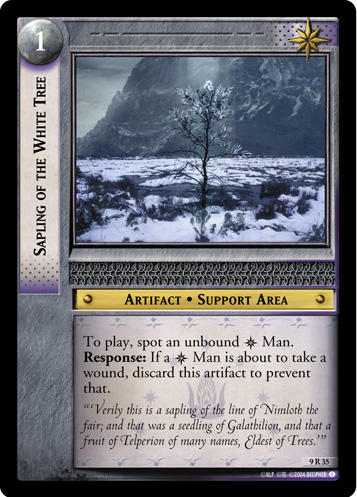 . (Response: If a
. (Response: If a Gondor Man is about to take a wound, discard this artifact to prevent that.) Because Sapling has prevented the effect (a wound) that would have prevented Morgul Destroyer's effect, the threats are now added.
- preventing effects section
Decks[edit]
- My old Dwarves / Morcs deck, a Movie Block deck by Freya on The Last Homely House forums
- Morgul Orcs: Wounds on the Ring-bearer, part of a guide to building Wraith decks in Standard format shortly after the release of Rise of Saruman, posted by Celebrimbor on the Cobracards forums. While the deck is for a now-obsolete Standard format, the advice applies equally well to Expanded.


